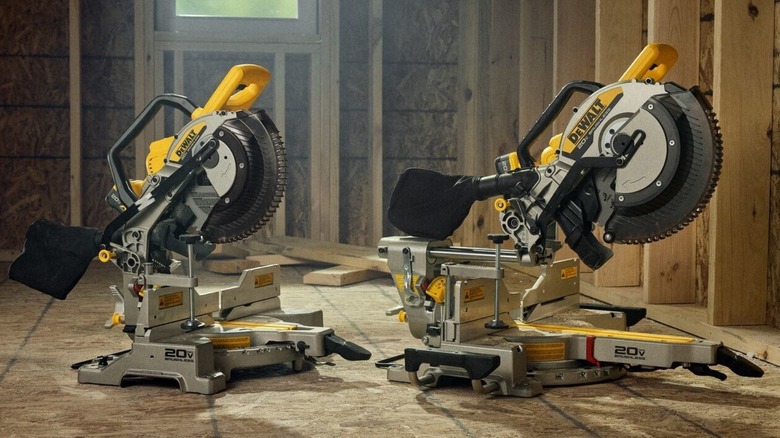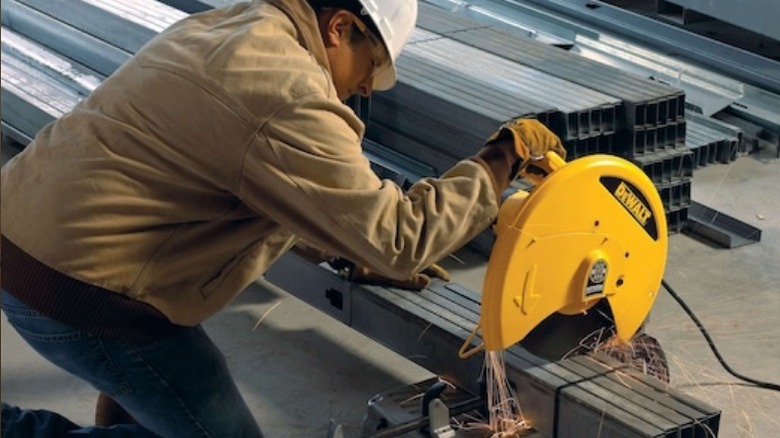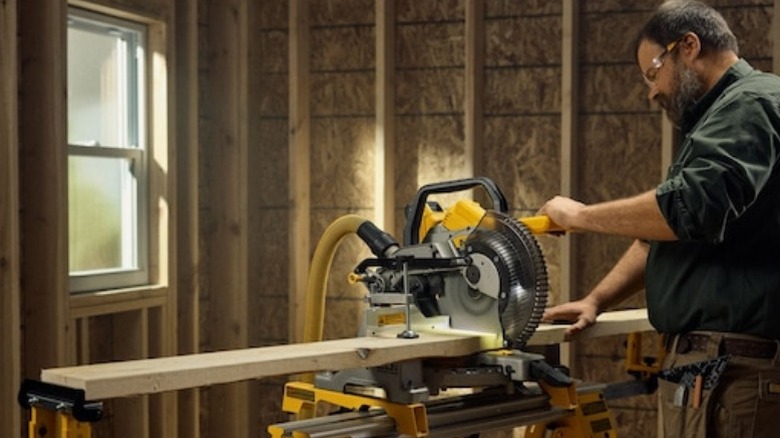What Is The Difference Between DeWalt's Chop Saw And Miter Saw?
We may receive a commission on purchases made from links.
The terms 'Chop Saw' and 'Miter Saw' are often used interchangeably, but this isn't quite correct. It's like calling a pencil a pen; it's easy to see the confusion, as both have a very similar design and serve a similar, though not identical, function. Both a chop saw and a miter saw are composed of radial saws that are mounted on a hinged arm and might even be able to perform many of the same tasks in a similar fashion. But as much as these two saws might look alike, they're actually two distinct power tools with several differences in their function, design, and intended use that set them apart.
DeWalt has a long-standing reputation as one of the best power tool brands on the market, and the company has both of these types of products available as part of its current line-up. But you'll probably want to know a bit more about what separates them before you run out and get one for your workshop, though, such as the differences in their function, what kinds of jobs each of them is better suited for, what models are available, and how much each of these models costs.
The DeWalt Chop Saw is better for metal
DeWalt currently has two chop saw models listed for sale: a standard 14-inch chop saw (D28730), which is currently available for $199.99, and another 14-inch chop saw that comes with DeWalt's Quik-Change Keyless Blade Change system (D28715) that can be found for $219.00. It seems that the Quik-Change system is the only major difference between these two, as both are corded tools, both use the same size blade, and both are powered by a 15-amp motor. But those who are interested in adding one of these DeWalt tools to their collection will first need to know how they're used.
These saws primarily use abrasive or carbide-tipped cutting disks that are ideal for cutting metal items such as pipes, rebar, metal drywall studs, and aluminum. Their 15-amp motors give them plenty of power to cut through these denser materials. This is why they are often used by plumbers, welders, construction workers, and other craftspeople who regularly need to cut metal. They are technically capable of cutting through softer materials, such as wood and plastic, though this generally isn't recommended due to their high rpm and the fact that finding the correct type of blades for a chop saw can be tricky, as this isn't really their intended purpose.
The DeWalt chop saws also include a pivoting fence that can be adjusted up to 45° for angled cuts. The saw itself is locked in a single position that only allows for vertical movement, however. It's not able to make beveled or compound cuts.
The DeWalt Miter Saw is better for wood and PVC
The miter saw is probably the tool that most home users will want in their garage, and it's undoubtedly one of the best DeWalt tools for woodworking. It seems the company is aware of that too, since it currently has significantly more of them in its catalog. There are no fewer than 21 different miter saw models currently listed on the DeWalt website. These range from 7 ¼-inches to 12-inches in blade size. There are a handful of corded models powered by 15-amp motors, but there are also several portable models that run on DeWalt's 20V Max, 60V Max, and 120V Max battery systems. Some of them also have sliding arms that allow them to make longer crosscuts, and other features such as double-bevel rotation and DeWalt's Cutline blade positioning system. The DeWalt 12-inch 15-Amp Single Bevel Miter Saw (DWS715) is one of the cheaper options available at $249.00, while something like the 60V 12-inch Cordless Sliding Miter Saw (DCS781B) will run you $699.00.
Miter saws are less focused on speed and power than chop saws and are more geared toward precision. They're primarily designed for cutting wood and trim, but can also be used to cut plastics, PVC, MDF, and a wide range of other materials. The blade is able to both rotate and tilt, which gives the person operating it a wider range of options. They can make angled, beveled, and compound cuts, which is particularly useful for woodworking joinery applications.


